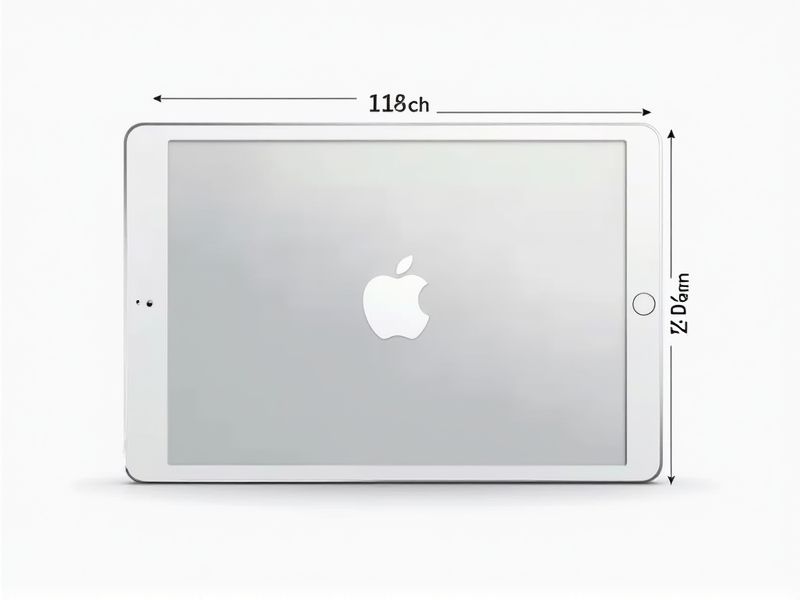
When choosing an iPad, it's helpful to be familiar with the standard dimensions to ensure compatibility with accessories or cases. For example, the iPad (10th generation) measures approximately 9.79 inches in height, 7.07 inches in width, and 0.28 inches in thickness. The iPad Pro 11-inch (4th generation) is about 9.74 inches by 7.02 inches by 0.23 inches, while the iPad mini (6th generation) is more compact at 7.69 inches by 5.3 inches by 0.25 inches. Always double-check the specific model dimensions before making a purchase, as sizes vary to accommodate different screen sizes and features.
Display Size Variations
The iPad offers a range of display sizes to suit diverse user preferences, including the compact 10.2-inch model, which is ideal for portability and casual use. In contrast, the 11-inch iPad Pro delivers enhanced performance and a larger workspace, perfect for professionals and creatives who require precision and detail. For those seeking the ultimate immersive experience, the 12.9-inch iPad Pro features a Liquid Retina XDR display, boasting 2732 x 2048 resolution and superior brightness levels. With these options, you can select a display size that best fits your needs, whether for reading, design, or entertainment.
Aspect Ratio
The iPad features a 4:3 aspect ratio, optimized for both productivity and entertainment. This ratio provides a balanced viewing experience, making it ideal for reading documents, browsing the web, and watching videos. With a resolution of up to 2732 x 2048 pixels in the iPad Pro models, the display delivers stunning clarity and vibrant colors. Your creative projects benefit from the ample screen space, allowing for a more immersive experience in drawing, video editing, and other tasks.
Resolution Differences
The iPad lineup features varied screen resolutions that significantly influence your viewing experience. For instance, the iPad Pro offers a Liquid Retina display with a resolution of 2732 x 2048 pixels, providing stunning clarity for professional tasks. In contrast, the standard iPad has a resolution of 2160 x 1620 pixels, which is suitable for everyday tasks and media consumption. Your choice of iPad should consider these resolution differences, impacting factors like visual detail and color accuracy.
Pixel Density
The pixel density of an iPad varies by model, with the latest models boasting up to 264 pixels per inch (PPI), ensuring sharp and detailed visuals. This high pixel density enhances your reading experience, making text crisp and images vibrant, ideal for creative tasks or consuming content. For example, the iPad Pro offers Liquid Retina display technology, providing a resolution of 2732 x 2048 pixels for stunning clarity. Such specifications make the iPad a leading choice for users prioritizing visual quality in a tablet.
Screen-To-Body Ratio
The iPad boasts an impressive screen-to-body ratio, with models like the iPad Pro achieving around 87% to 90%. This design maximizes the display area while minimizing the bezels, providing an immersive viewing experience for users. With a stunning Liquid Retina display that can reach up to 120Hz, your content appears remarkably smooth and vibrant. Understanding this specification can enhance your purchasing decision, ensuring you choose the iPad that best aligns with your needs for visual engagement.
Device Thickness
The iPad's design prioritizes a sleek profile, with the latest models achieving a thickness of just 7.5 mm, making it one of the thinnest tablets on the market. This lightweight structure does not compromise performance, as Apple integrates powerful processors and advanced display technology within this compact form. The minimalistic thickness enhances portability, allowing you to easily carry the device in a bag or even a large pocket. To further optimize user experience, the design remains ergonomic, ensuring comfort during prolonged usage.
Weight Variations
The weight of the iPad varies depending on the model, with the iPad Mini weighing approximately 0.66 pounds (0.3 kg), while the iPad Pro can reach up to 1.5 pounds (0.68 kg) for the 12.9-inch version. Apple has meticulously designed each iteration to balance portability with functionality, ensuring that even the lightest models still provide robust performance for tasks like streaming, gaming, and productivity. Your choice of iPad will significantly depend on how weight affects your usage scenarios, such as travel or extended use. The introduction of lightweight materials has allowed Apple to create devices that do not compromise on capability while being easy to carry.
Bezel Size
The iPad features a minimal bezel size that enhances the overall screen-to-body ratio, which is approximately 82.9%. This design allows for a more immersive viewing experience, particularly beneficial for activities like gaming and video streaming. The latest iPad models, including the iPad Pro, achieve a sleek aesthetic with a bezel as slim as 6.3mm. Such advancements not only improve functionality but also contribute to a lightweight design, making it easier for you to carry and use the device on the go.
Overall Dimensions
The latest iPad model measures 247.6 mm in height, 178.5 mm in width, and just 6.1 mm in thickness, making it both lightweight and portable. With a display size of 10.9 inches, it offers a resolution of 2360 x 1640 pixels, ensuring vibrant visuals and sharp text. The device's weight is approximately 478 grams for the Wi-Fi model, providing easy handling for extended periods. Its sleek design complements modern aesthetics, facilitating seamless integration into your daily tech environment.
Port Configuration
The iPad features a comprehensive port configuration that includes a USB-C port, allowing for versatile connectivity options. With support for USB 3.1 Gen 2 speeds, you can transfer data at rates of up to 10 Gbps. The device's compatibility with various accessories, such as displays and cameras, enhances your productivity and creative potential. Additionally, the iPad supports charging via the USB-C port, providing a fast and efficient way to power your device on-the-go.
